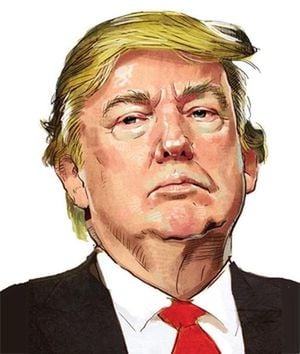On August 15, 2025, the world’s attention turned north as US President Donald Trump and Russian President Vladimir Putin met face-to-face at Joint Base Elmendorf-Richardson in Anchorage, Alaska. The occasion, described as a “three-on-three” summit, brought together top officials from both sides to tackle the ongoing war in Ukraine, as well as a host of bilateral issues, including the future of Arctic cooperation. The meeting—held without Ukrainian President Volodymyr Zelenskiy or most European leaders—quickly became a focal point for speculation, analysis, and, not least, diplomatic maneuvering.
According to Politico and Censor.NET, Finnish President Alexander Stubb, who has maintained close contact with Trump thanks in part to their shared love of golf, offered a unique window into the American leader’s evolving approach to Russia. Stubb observed that Trump had shifted gears in his dealings with Putin, moving from what he called a policy of “carrots” to one of “sticks.” In Stubb’s words: “Having seen that carrots rarely work with the Russians, he has moved to the stick stage. Now it’s just a question of how big the stick is going to be.”
Stubb’s comments, made at a press conference in Riga, Latvia, on September 16, underscored a growing belief among some European leaders that Trump’s public criticism of Putin might soon translate into concrete action. While some capitals remain skeptical, viewing Trump’s rhetoric as more declarative than actionable, Stubb insisted that his personal rapport with the US president—honed over “joint golf meetings”—gave him reason to trust Trump’s intentions.
Pressed on what form this “stick” might take, Stubb responded with a touch of humor, suggesting it could be a “driver”—a nod to both golf and the wide range of tools Trump might wield. But the Finnish leader was clear about the seriousness of the situation. He noted that Washington was actively weighing several levers of pressure, including tightening sanctions (even secondary ones), raising tariffs, and potentially leveraging the US military to deter further Russian escalation in Ukraine.
Stubb also issued a warning: if Putin continued to shell Ukrainian civilians after the Alaska meeting, Trump would be compelled to respond in line with US strategic interests. In Stubb’s view, “he is working if not around the clock, then every day with trying to end the war” and “he has 14 clubs in his bag.” The implication was unmistakable—Trump’s approach might be unconventional, but it was, as Stubb put it, “quite results-oriented.”
For his part, Trump has not shied away from voicing his frustration with Putin. As reported by The Telegraph, the president remarked during an event in Alaska: “We met with Putin in Alaska. We had a good meeting. Then he came back and started sending drones to Kiev.” Trump, who at 79 has never been one to mince words, confronted Putin directly: “I said to him: I thought we had a good meeting. You don’t look well. You’ve been fighting a war for four years that should have been over in a week. Are you a paper tiger? I’m very disappointed in Putin.”
Trump’s disappointment is not new. He has repeatedly asserted that, had he been president earlier, the war in Ukraine would not have happened—or at least would have been resolved far more quickly. This blunt assessment, delivered at a critical moment for both the conflict and US-Russia relations, has sent ripples through diplomatic circles. The Ukrainian president, for his part, described the Alaska summit as a personal victory for Putin, arguing that the absence of Ukraine and most European leaders allowed the Russian leader to project strength and seek relief from international isolation and sanctions.
After the meeting, both sides issued statements. Trump spoke of “progress” and his desire to see stable relations with Russia after the war’s end, while Putin said Trump “aims to help resolve the Ukrainian issue.” Yet, according to The Wall Street Journal, planned expanded negotiations were abruptly canceled, leaving many to wonder what, if any, concrete agreements had been reached.
Trump did not let the matter rest. He immediately held phone calls with Zelenskiy and leaders from the EU and NATO, making it clear that his focus was on a genuine peace agreement between Ukraine and Russia—not simply a ceasefire. Stubb, describing himself as a “realist optimist,” urged Ukraine’s supporters to remain patient, emphasizing the need for tangible steps in both diplomacy and security.
Meanwhile, the Alaska summit sparked fresh debate about the future of Arctic cooperation. As reported by the South China Morning Post, both American and Russian policymakers floated the possibility of joint ventures in the far north, focusing on resources, shipping, and geopolitical interests. “Arctic cooperation was raised by both American and Russian policymakers because both sides are aware of their common interests in the region,” said Pavel Devyatkin, a senior associate at The Arctic Institute. He pointed to energy, shipping routes, and infrastructure as areas of mutual benefit, and noted that “influential members” in both the White House and the Kremlin were eager to use Arctic cooperation as a stepping stone toward normalizing US-Russia relations.
However, the prospect of Arctic collaboration is complicated by the growing importance of China in the region. Xu Qingchao, a professor at Beijing Language and Culture University, observed that any US-Russia economic cooperation in the Arctic would overlap significantly with existing China-Russia projects, particularly in resources, energy, and shipping. The question remains: Can the US and Russia find common ground in the Arctic while tensions over Ukraine remain unresolved?
Stubb, for his part, sees a broader strategic picture. He has advocated for accelerating Ukraine’s accession to the European Union, even suggesting that flexible solutions be found to bypass Hungary’s veto. “The sooner this happens, the better for the region,” he said, highlighting Finland’s commitment to Ukraine’s European future.
As the dust settles from the Alaska summit, the world is left to grapple with a complicated reality. Trump’s approach to Putin has undeniably shifted—from carrots to sticks, from hopeful engagement to the threat of real consequences. But whether this new strategy will hasten the end of the war in Ukraine, reshape US-Russia relations, or even unlock new avenues for Arctic cooperation remains to be seen. For now, the only certainty is that the stakes—diplomatic, economic, and human—couldn’t be higher.




